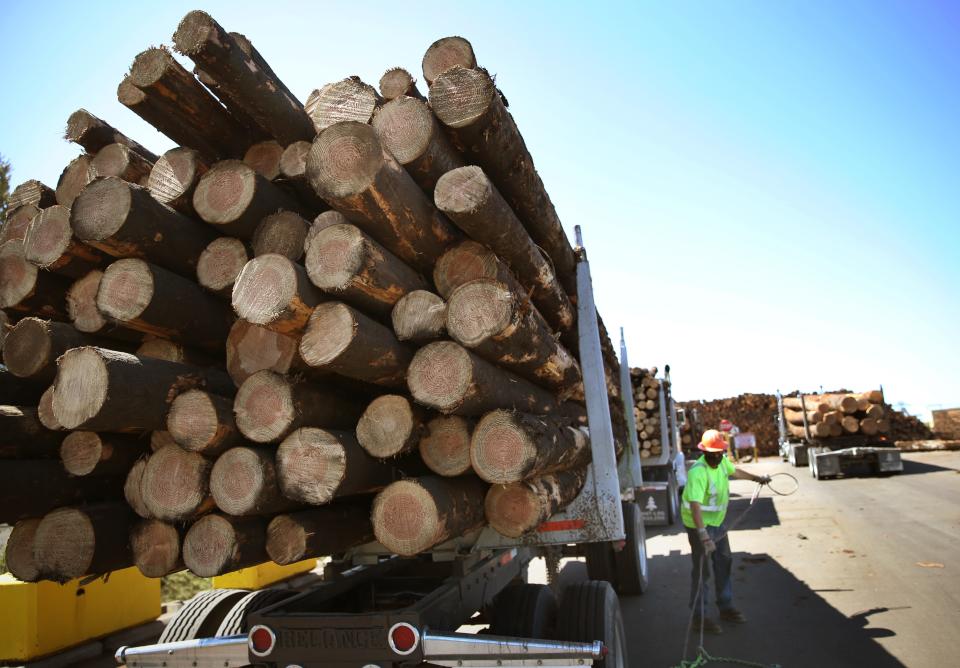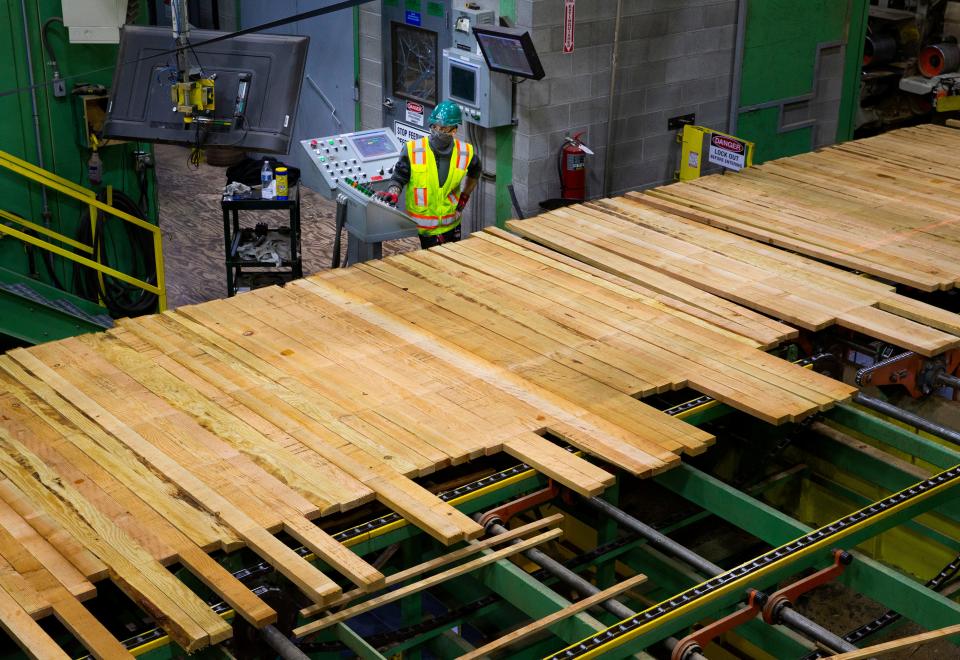With rebuilding underway in Oregon fire zones, price of lumber reaches new highs
There’s no shortage of logs on the highways leaving fire-ravaged parts of Oregon like the Santiam Canyon and the McKenzie River Valley, but residents looking to rebuild will pay top dollar to see them return as lumber.
A low supply of and high demand for lumber has brought prices to record highs in recent weeks with expectations that they will continue to rise. The market swing comes as debris from the 2020 Labor Day wildfires is being cleared away and survivors are planning their rebuilds.
About 700 homes were lost in Santiam Canyon cities like Mill City, Detroit, Lyons and Gates. More than 400 homes in the McKenzie River Valley burned during that fire, sparked in a Labor Day windstorm before spreading over 173,000 acres. It was just one of the large wildfires to sweep across Oregon that altogether burned an estimated 1 million acres.
Rob Freres, president of Freres Engineered Wood, said raw wood prices have gone up by a third since the beginning of the pandemic. That is despite an influx of burned wood to mills.
He said wholesale prices of plywood – 1,000 square feet – have been on a roller coaster in the same span, from $400 before the pandemic to a high of $2,100 in the summer of 2021 and now down to $700.
To the average consumer, that means a 4-by-8 sheet of plywood went from about $13 to high of about $48 down to about $24.
“We’re really quite concerned at $700 because we’re losing money at that level,” Freres said. “To be 40% higher than your previous all-time high and to lose money is kind of the situation we’re in. It’s just, it’s absolutely mind numbing how we are dealing with the wild swings in the marketplace and dealing with the challenges of finding a work force. I don’t know that it’s ever been so unpleasant, all the various challenges we’ve had the last couple of years.”
Highway’s like 99 and 126 maintain steady streams of log trucks taking scorched logs out of the fire zone. State and county officials and private landowners have felled thousands of dangerous and burnt black trees and are sending as many as they can to the sawmill.
It was rare when burned logs were processed by a mill before the wildfires.
“We have a tremendous amount of black logs coming at us. We’d never run a black log through our mill prior to recently,” said Seneca Sawmill Co. Senior Vice President of Marketing and Communications Casey Roscoe. “Every timberland owner that had salvageable timber wanted to get value from it because they're up against a timeline.”
But lumber prices have been on the rise, and a number of conditions related to the pandemic are expected to keep lumber — and new homes — expensive.
Marion County community development manager Chris Eppley said Wednesday that 451 homes that were destroyed in Marion and Linn counties have applied for septic permits. That about 75% of those that were destroyed.
“Our building official is aware of a handful of projects that have recently been canceled or delayed by applicants who cite rising lumber prices as the reason for the withdrawal of their building permit applications,” Lane County spokeswoman Devon Ashbridge said.
Lumber markets
The average price of a new single-family home increased by more than $24,000 between April 2020 and March, according the National Association of Home Builders. On Thursday, lumber closed at $1,260 per 1,000 board feet, a record high price and up nearly 280% from the same time last year.
Freres said finding enough workers has been a challenge, especially since the wildfires. There are fewer workers to draw from in logging and manufacturing in wood products in the Santiam Canyon with over 2,800 people displaced.
He said the company that produces wood products like plywood and mass ply paneling has about 410 workers. Previously it would have close to 500.
“Last year, for example, we could only make 55% of the plywood we would normally make and 75% of the veneer products,” Freres said. “And this was in an extraordinarily high market. It was completely labor driven, lack of labor driven.
“We need 100 people to get back to our normal levels and we are not unique in our industry and the entire manufacturing sector across America.”
Prices are expected to rise further in coming months.

Last year's pandemic-caused lumber market disruptions are largely to blame for the high prices, and they include shifts in homebuilding trends, layoffs at sawmills and limited production as the virus appeared. Demand is high, and producers are trying to keep up.
Sawmills began limiting production and, in some cases, laying off workers during the pandemic's early months. New home construction also stalled around the same time.
“We were making a product nobody was buying,” Roscoe said.
Seneca didn't lay off employees, but reduced hours and shifted production crews to other duties. But before long, the pandemic created a lumber demand: People were now shopping for homes with months of isolation ahead and starting do-it-yourself projects.
Demand for wood continued to grow through 2020 and into 2021, and prices kept rising.
It isn’t for a lack of wood: U.S. timber production in February reached a 13-year high.
“The lumber market is extremely strong. It's the highest since I've been in business, and I've been in business 39 years,” said Mike Pihil, owner of Mike Pihil Logging Co. and president of Oregon natural resources worker advocacy group Timber Unity. “It’s not really helping out the loggers right now because there are so many logs on the market.”
Oregon's 2020 wildfires have created an excess of locally available timber, Pihil said. Many landowners are salvaging what they can before the wood becomes unusable.
“This is an epic event. We’ve never seen this in our lifetime and hopefully we'll never see it again,” Pihil said. “But just wait. Two years from now, there’s not going to be any logs on the market because that 40-year supply is gone. It was burnt up and sent to the mill.”
Roscoe said availability of wood is only one part of the equation. Lumber mills need time to scale up production, but other aspects of the market are in disarray, including the loss of harvesting equipment in the fires and altered timber harvesting timelines statewide.
“There’s a lot of access to wood right now to the degree mills are willing to take black logs, so that part is good,” Roscoe said. “But there's layers of complexity on everything.”
A costly time to rebuild
How deeply the cost of building materials will affect those trying to rebuild after the fires will depend much on how well their insurance policies will adjust to those rising prices.

Blue River resident Terry Herndon has had the ash and debris cleared away from his lot and is in the early stages of rebuilding efforts. He recently spoke with his insurance company and was told his replacement cost policy would cover the rising cost of lumber.
“They wanted a quote. The longer it takes, the more it's going up,” Herndon said.
From the trailer on her parents' property, Melanie Stanley can see the now-cleared lot where her Blue River home stood before the Holiday Farm Fire. There are already a number of things weighing on her rebuilding plans, such as building permits and septic systems.
Add to it the rising cost of materials to rebuild her home and her store.
“Most people aren’t insured well enough to be able to deal with the full replacement costs with the price of lumber,” she said. “Nobody foresees a 300% increase in the cost of building materials. That's kind of where everything is sitting: exponential increases.”
Stanley said her insurance likely will make possible rebuilding her home back to what it was before the fire, but she had hoped to build back her store, Meyer’s General Store and Liquor Shop, bigger and better. Now she expects to have to scale back those plans.
“Where we may have been looking at hopefully upgrading the size of the building ... we may not be able to do that now simply because of the cost,” Stanley said.
Supply chain issues are limited to just wood products at the major lumber mills. It’s hitting all wood products.
Freres said he waited over a year for two deck chairs to be delivered to his house last weekend.
“Just for two chairs,” he said. “They’re nothing extraordinary. They’re just two wooden chairs with cushions on the back and on the seat. Two of them.”
This article originally appeared on Salem Statesman Journal: With rebuilding underway in Oregon fire zones, price of lumber reaches new highs

